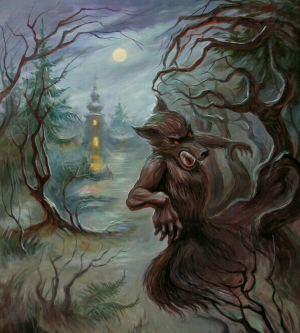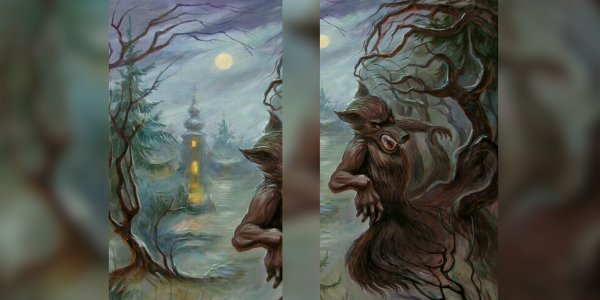This mind-bending optical illusion might uncover the secret way you express love to your partner!
By
VanessaC
- Replies 17
Love can be expressed in many different ways, some more obvious than others.
And this mind-bending optical illusion by Ukrainian artist Oleg Shupliak claimed to reveal the secret way you show love to your partner.
Shupliak is known for his surreal, dreamlike artworks that feature optical illusions and hidden imagery, inviting viewers to delve deeper into their subconscious minds.
This specific illusion features an angry wolf running from a quaint home into a moonlit forest.
At first glance, it looks like a normal scenic painting. But if you look closer, the elements combine to form two hidden faces in the trees and shrubbery.
Moreover, according to YourTango, what you notice first in this puzzle can supposedly uncover how you quietly communicate love to your significant other.
Spotting the trees first means you've been hurt before, so you show love by opening up.
On the other hand, noticing the moon first indicates you're a ‘dreamer at heart' who values their creativity. These people share their love artistically and not necessarily through words.
Those fixated on the wolf are known to be passionate, and their way of expressing their love is through physical touch.
Moreover, those who see the house in the background first love feeding others baked goods and hearty home-cooked meals.
Finally, the first face is hidden amongst the shrubbery, trees, and the house while the other is created by the wolf’s body and the trees.
As these are hidden, those who spot one or both are known to have a high level of intuition about others.
However, those who could not spot the faces are said to express their love through quality time with their significant others.
But do optical illusions really hold the key to understanding love languages?
Experts warned against putting too much faith in these popular personality tests.
Simine Vazire, a Personality Researcher at the University of California, Davis, cautioned everyone saying: 'You should be sceptical.'
'Until we test them scientifically we can’t tell the difference between that and pseudoscience like astrology.'
The Five Love Languages
Furthermore, the idea of 'love languages' stems from Gary Chapman's 1992 book, titled The 5 Love Languages, which claimed people give and receive love in five distinct ways: physical touch, quality time, words of affirmation, acts of service, and gift-giving.
The first 'love language,' as Chapman explains, is physical touch. This isn't restricted merely to amorous contact but includes any process of physical connection, such as a comforting hug, an affirmation pat on the back, or a gentle brushing of hair. Love, for the individuals who prioritise physical touch, is best depicted as a tactile experience.
The second 'love language,' words of affirmation, involves uttering supportive, positive words to your partner. Simple sentences like 'I’m proud of you', 'I admire your determination', or 'Your smile brightens my day' can be incredibly effective expressions of love for people who understand this language best.
Next is quality time. This love language revolves around the concept of undivided attention and presence. Leaving aside all distractions and investing your unalloyed focus in your loved one is the quintessence of expressing love through quality time.
Acts of service, the fourth in Chapman’s list of love languages, can be interpreted as 'actions speak louder than words'. Small deeds like making a favourite meal, helping with chores, or assisting in tasks that indicate an 'I’m here to lend a helping hand' attitude, radiate love in a discreet yet profound way.
The final 'love language' is receiving gifts. However, this doesn't necessarily mean luxury items or expensive possessions. It’s the thoughtfulness and effort behind the gift that matter. A heartfelt, hand-written letter, for instance, can mean more to someone than a shop-bought item of high monetary value.
Of course, these love languages are not mutually exclusive, and individuals can express and perceive love in more than one way. Much like the fascinating optical illusions by Oleg Shupliak, deciphering these languages involves a deep, introspective look into one's soul.
And as we journey through relationships, we may find our love languages evolving and expanding, expressing our affection in ways uniquely tailored to us and our partners.

So which one did you notice first, dear members? Did it reveal anything about you? Do you agree with it? Let us know how you show your love to your partners in the comments section below!
And this mind-bending optical illusion by Ukrainian artist Oleg Shupliak claimed to reveal the secret way you show love to your partner.
Shupliak is known for his surreal, dreamlike artworks that feature optical illusions and hidden imagery, inviting viewers to delve deeper into their subconscious minds.
This specific illusion features an angry wolf running from a quaint home into a moonlit forest.
At first glance, it looks like a normal scenic painting. But if you look closer, the elements combine to form two hidden faces in the trees and shrubbery.
Moreover, according to YourTango, what you notice first in this puzzle can supposedly uncover how you quietly communicate love to your significant other.
Spotting the trees first means you've been hurt before, so you show love by opening up.
On the other hand, noticing the moon first indicates you're a ‘dreamer at heart' who values their creativity. These people share their love artistically and not necessarily through words.
Those fixated on the wolf are known to be passionate, and their way of expressing their love is through physical touch.
Moreover, those who see the house in the background first love feeding others baked goods and hearty home-cooked meals.
Finally, the first face is hidden amongst the shrubbery, trees, and the house while the other is created by the wolf’s body and the trees.
As these are hidden, those who spot one or both are known to have a high level of intuition about others.
However, those who could not spot the faces are said to express their love through quality time with their significant others.
But do optical illusions really hold the key to understanding love languages?
Experts warned against putting too much faith in these popular personality tests.
Simine Vazire, a Personality Researcher at the University of California, Davis, cautioned everyone saying: 'You should be sceptical.'
'Until we test them scientifically we can’t tell the difference between that and pseudoscience like astrology.'
The Five Love Languages
Furthermore, the idea of 'love languages' stems from Gary Chapman's 1992 book, titled The 5 Love Languages, which claimed people give and receive love in five distinct ways: physical touch, quality time, words of affirmation, acts of service, and gift-giving.
The first 'love language,' as Chapman explains, is physical touch. This isn't restricted merely to amorous contact but includes any process of physical connection, such as a comforting hug, an affirmation pat on the back, or a gentle brushing of hair. Love, for the individuals who prioritise physical touch, is best depicted as a tactile experience.
The second 'love language,' words of affirmation, involves uttering supportive, positive words to your partner. Simple sentences like 'I’m proud of you', 'I admire your determination', or 'Your smile brightens my day' can be incredibly effective expressions of love for people who understand this language best.
Next is quality time. This love language revolves around the concept of undivided attention and presence. Leaving aside all distractions and investing your unalloyed focus in your loved one is the quintessence of expressing love through quality time.
Acts of service, the fourth in Chapman’s list of love languages, can be interpreted as 'actions speak louder than words'. Small deeds like making a favourite meal, helping with chores, or assisting in tasks that indicate an 'I’m here to lend a helping hand' attitude, radiate love in a discreet yet profound way.
The final 'love language' is receiving gifts. However, this doesn't necessarily mean luxury items or expensive possessions. It’s the thoughtfulness and effort behind the gift that matter. A heartfelt, hand-written letter, for instance, can mean more to someone than a shop-bought item of high monetary value.
Of course, these love languages are not mutually exclusive, and individuals can express and perceive love in more than one way. Much like the fascinating optical illusions by Oleg Shupliak, deciphering these languages involves a deep, introspective look into one's soul.
And as we journey through relationships, we may find our love languages evolving and expanding, expressing our affection in ways uniquely tailored to us and our partners.
Key Takeaways
- An optical illusion created by Ukrainian artist Oleg Shupliak reveals hidden personality traits and love languages based on what the observer sees first in the artwork.
- The image features an angry wolf running from a home into a moonlit forest, with various elements potentially seen first including the trees, moon, wolf, the house, or hidden faces.
- Seeing different elements first indicates different love languages.
- Shupliak is known for his artworks consisting of optical illusions and hidden imagery.
Last edited:










